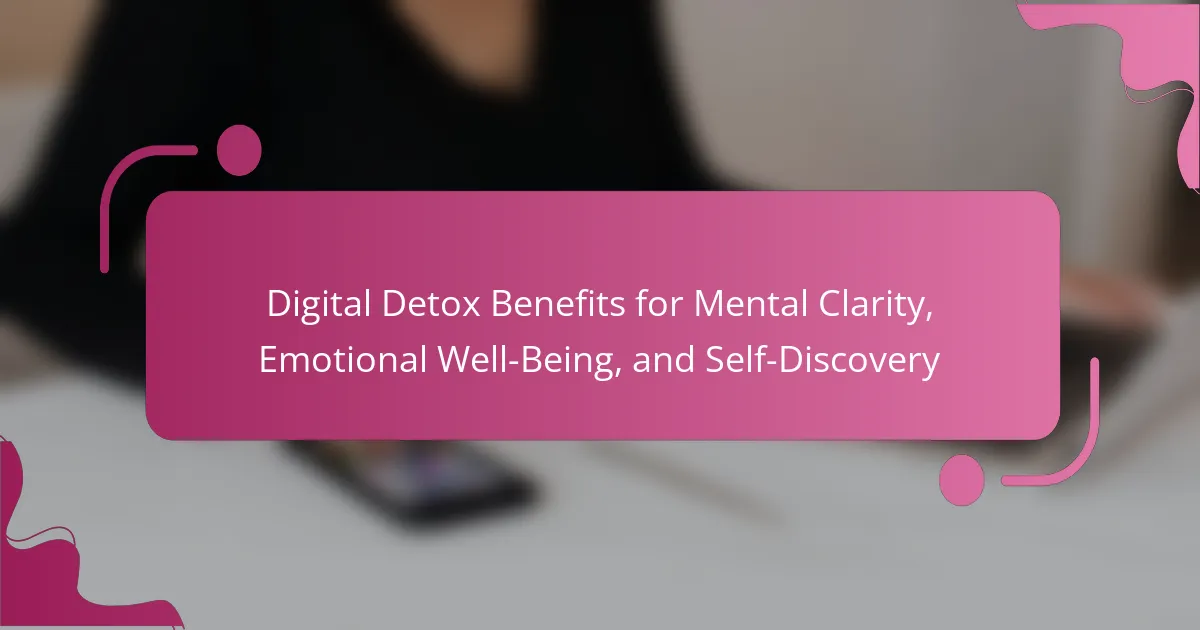A digital detox can significantly enhance mental clarity, emotional well-being, and self-discovery. By reducing distractions, it improves focus and lowers stress levels. Disconnecting from devices fosters mindfulness and self-awareness, promoting personal growth. Engaging in this practice can lead to increased productivity and creativity, revealing personal values and aspirations.
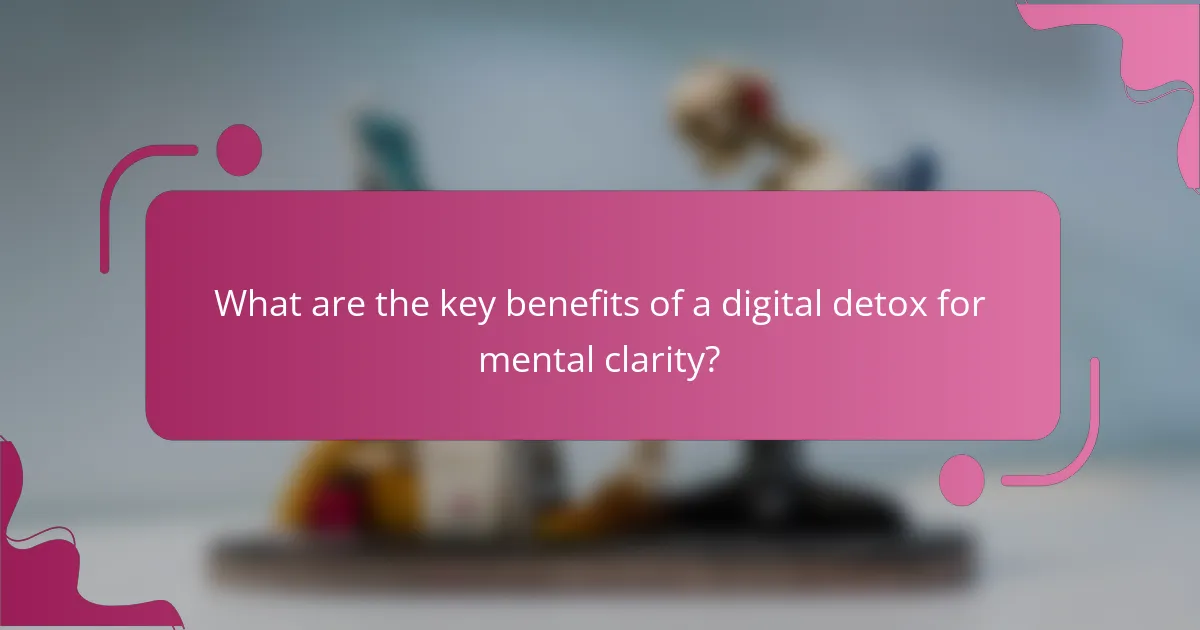
What are the key benefits of a digital detox for mental clarity?
A digital detox enhances mental clarity by reducing distractions and improving focus. This practice fosters emotional well-being by lowering stress and anxiety levels. Disconnecting from devices allows for deeper self-discovery and reflection, promoting personal growth. Studies indicate that individuals experience increased productivity and creativity post-detox, reinforcing the benefits of intentional breaks from technology.
How does reducing screen time enhance cognitive function?
Reducing screen time enhances cognitive function by improving focus, memory, and problem-solving skills. A digital detox allows the brain to recharge, leading to increased mental clarity. Studies show that excessive screen exposure can hinder cognitive performance, while reduced screen time fosters better attention and retention. Engaging in offline activities stimulates critical thinking and creativity, promoting emotional well-being and self-discovery.
Which mental health improvements are linked to digital detoxing?
Digital detoxing can lead to significant mental health improvements, including enhanced clarity, emotional stability, and self-awareness. Reduced screen time decreases anxiety and promotes mindfulness, allowing individuals to reconnect with their thoughts and feelings. Studies indicate that participants experience lower stress levels and improved mood after a digital detox, with some reporting increased creativity and productivity. Engaging in offline activities fosters deeper social connections and self-discovery, enhancing overall emotional well-being.
What role does mindfulness play in achieving mental clarity during a detox?
Mindfulness significantly enhances mental clarity during a digital detox by fostering present-moment awareness. This practice reduces distractions and cultivates a deeper connection to thoughts and emotions. Engaging in mindfulness techniques, such as meditation or focused breathing, can improve emotional regulation and promote self-discovery. Research indicates that mindfulness can lead to a 30% increase in cognitive flexibility, allowing for clearer decision-making. By incorporating mindfulness into a detox, individuals may experience heightened awareness of their digital habits, leading to more intentional technology use and improved overall well-being.
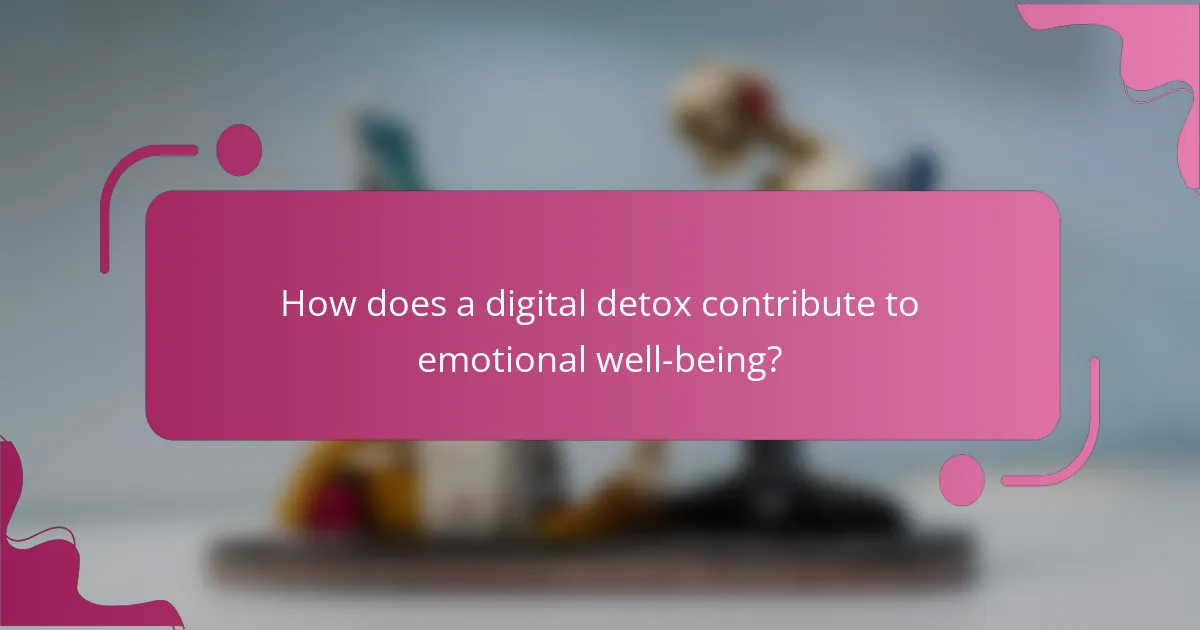
How does a digital detox contribute to emotional well-being?
A digital detox significantly enhances emotional well-being by reducing stress and improving mood. Disconnecting from technology fosters mindfulness, allowing individuals to reconnect with themselves and their surroundings. This break from screens can lead to increased self-awareness and better emotional regulation. Studies show that even short digital detoxes can result in lower anxiety levels and improved life satisfaction.
What emotional challenges can be alleviated through reduced digital engagement?
Reduced digital engagement can alleviate emotional challenges such as anxiety, stress, and feelings of isolation. By decreasing screen time, individuals may experience enhanced mental clarity and improved emotional well-being. This detox can lead to better self-discovery and stronger interpersonal connections. Studies show that excessive digital consumption correlates with increased levels of anxiety and depression, while reduced engagement fosters mindfulness and emotional resilience.
Which coping strategies can support emotional resilience during a detox?
Effective coping strategies during a detox include mindfulness practices, physical activity, and social support. Mindfulness enhances emotional awareness and reduces stress. Engaging in physical activities boosts mood and energy levels. Connecting with supportive friends or family provides encouragement and accountability. These strategies foster emotional resilience and improve overall well-being during the detox process.
How can social connections be maintained without digital devices?
Social connections can be maintained without digital devices through face-to-face interactions, handwritten letters, or engaging in shared activities. These methods foster deeper emotional bonds and enhance mental clarity. Spending time outdoors or participating in community events encourages socialization and strengthens relationships. Engaging in hobbies together can create lasting memories and provide a sense of belonging. Prioritizing these offline interactions contributes significantly to emotional well-being and self-discovery.
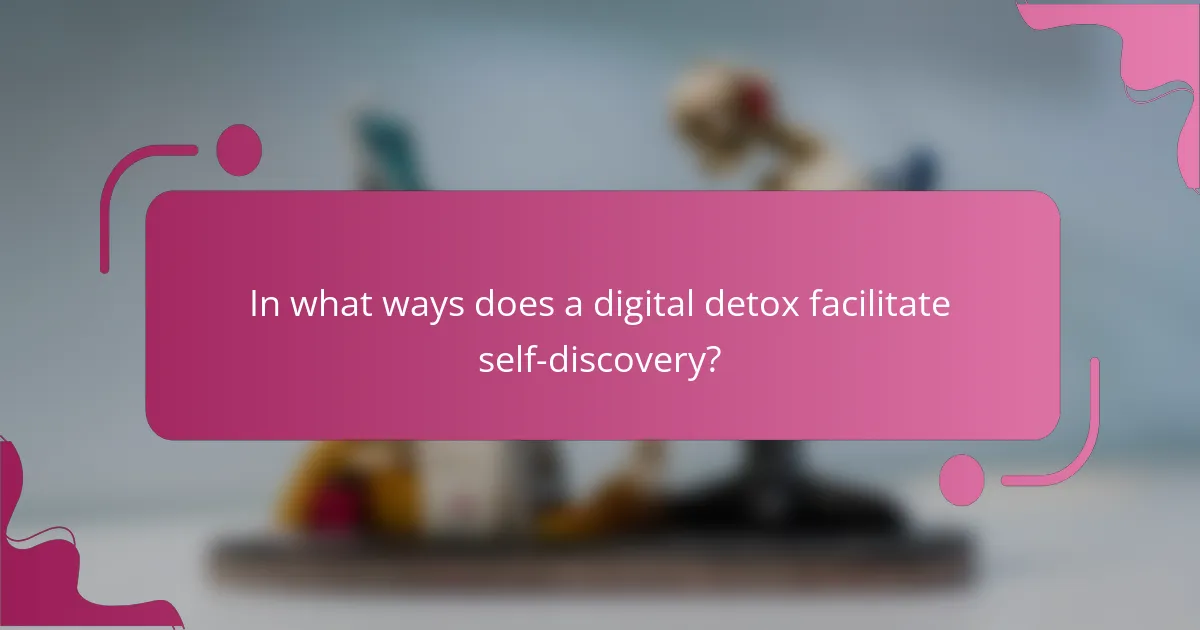
In what ways does a digital detox facilitate self-discovery?
A digital detox enhances self-discovery by fostering mental clarity and emotional well-being. Disconnecting from digital distractions allows individuals to reflect on their thoughts and feelings. This process can lead to greater self-awareness and personal insights. Additionally, reduced screen time encourages engagement in activities that promote creativity and mindfulness, further supporting self-exploration. Embracing a digital detox can reveal personal values and aspirations, guiding individuals toward a more authentic life.
What activities promote self-reflection during a digital detox?
Engaging in activities like journaling, meditation, nature walks, and creative arts promotes self-reflection during a digital detox. These activities encourage introspection and emotional processing, enhancing mental clarity and emotional well-being. Journaling allows for personal insights, while meditation fosters mindfulness. Nature walks connect individuals with their surroundings, and creative arts provide an expressive outlet. Together, these practices facilitate self-discovery and personal growth.
How does disconnecting from technology help clarify personal values?
Disconnecting from technology enhances personal values by fostering self-reflection and reducing distractions. This break allows individuals to reconnect with their thoughts and feelings, leading to clearer priorities. Studies show that a digital detox can improve emotional well-being, as it encourages mindfulness and reduces anxiety. By stepping away from constant notifications, people often rediscover what truly matters in their lives, promoting authentic self-discovery.
Which insights can emerge from a period of digital disconnection?
Digital disconnection can lead to increased mental clarity, improved emotional well-being, and deeper self-discovery. Insights often include heightened awareness of personal thoughts and feelings, enhanced focus on present experiences, and a renewed appreciation for offline relationships. These benefits promote resilience against stress and anxiety, fostering a healthier mindset. Engaging in a digital detox encourages reflection, allowing individuals to reassess priorities and values, ultimately guiding personal growth.
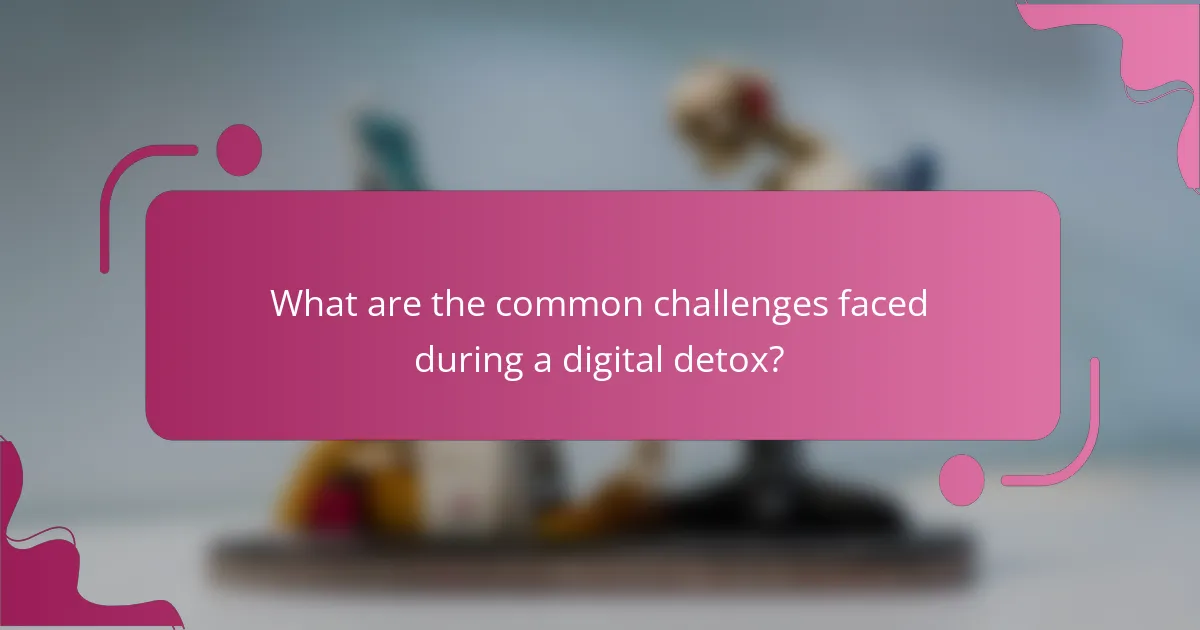
What are the common challenges faced during a digital detox?
Digital detoxes often present challenges that can hinder the process. Common difficulties include withdrawal symptoms, which may manifest as anxiety or irritability due to reduced screen time. Additionally, social pressures can arise, as individuals may feel disconnected from friends or family who are still engaged online. Another challenge is the temptation to revert to old habits, especially when faced with boredom or stress. Lastly, the lack of immediate benefits can lead to frustration, making it hard to stay committed to the detox.
How can withdrawal symptoms be managed effectively?
Withdrawal symptoms can be managed effectively through structured digital detox strategies. Gradually reducing screen time helps ease the transition. Engaging in mindfulness practices promotes emotional well-being and mental clarity. Physical activities, such as exercise, support self-discovery and reduce anxiety. Establishing a support network fosters accountability and encouragement. Lastly, journaling can enhance self-reflection and emotional processing during the detox.
What strategies can help maintain motivation throughout the detox process?
Setting clear goals and creating a structured plan can help maintain motivation during a digital detox. Establish specific objectives, such as reducing screen time or engaging in offline activities.
Incorporating regular check-ins can track progress and reinforce commitment. Celebrating small achievements fosters a sense of accomplishment.
Engaging with supportive communities enhances accountability and provides encouragement. Sharing experiences with others can deepen self-discovery and emotional well-being.
Lastly, reflecting on the benefits gained, such as improved mental clarity, can sustain motivation throughout the detox journey.
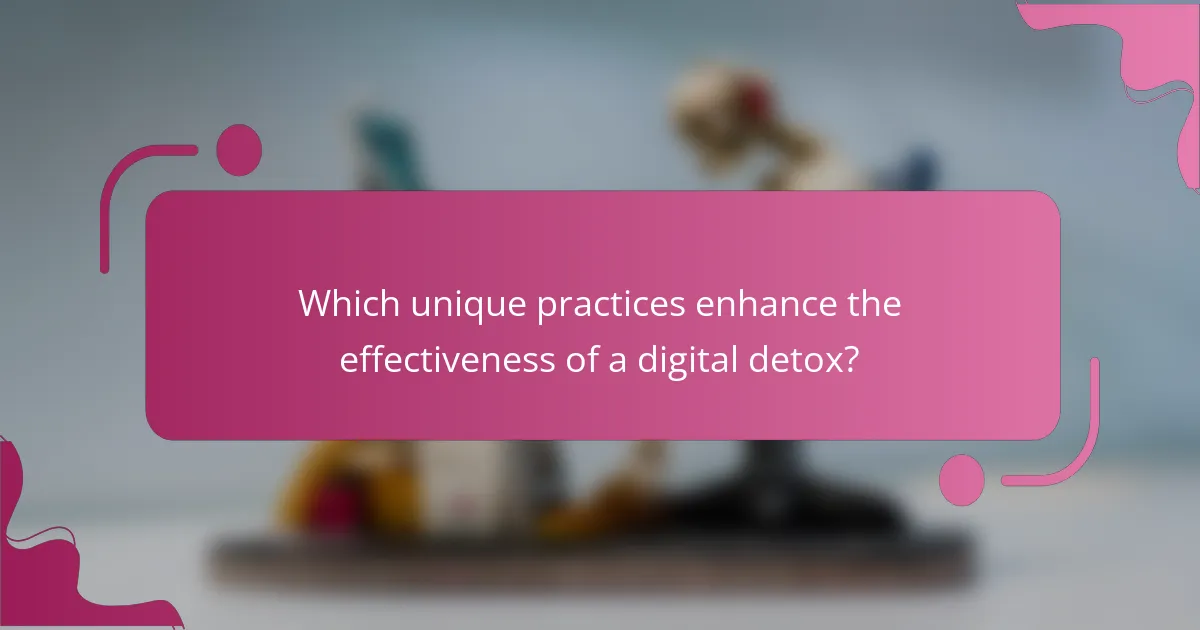
Which unique practices enhance the effectiveness of a digital detox?
Engaging in unique practices can significantly enhance the effectiveness of a digital detox. Mindfulness meditation promotes mental clarity by fostering present-moment awareness. Nature immersion reduces stress and improves emotional well-being through natural stimuli. Journaling facilitates self-discovery by encouraging reflection on thoughts and feelings. Setting specific detox goals ensures focused progress and accountability. Establishing tech-free zones creates a physical space for disconnection and relaxation. Lastly, practicing digital minimalism helps prioritize meaningful interactions over superficial ones.
How does incorporating nature into a detox routine improve outcomes?
Incorporating nature into a detox routine significantly enhances mental clarity, emotional well-being, and self-discovery. Exposure to natural environments reduces stress and anxiety levels, promoting relaxation. Studies show that spending time outdoors can improve focus and cognitive function. Nature stimulates the senses, fostering mindfulness and self-reflection. Engaging with the outdoors during a digital detox leads to deeper personal insights and emotional healing.
What role does journaling play in the self-discovery process during a detox?
Journaling plays a crucial role in the self-discovery process during a digital detox by facilitating reflection and clarity. It allows individuals to articulate thoughts and emotions, uncover patterns, and gain insights into their behaviors. This practice enhances emotional well-being by providing a safe space for expression, promoting mindfulness, and reducing mental clutter. As a result, journaling can lead to a deeper understanding of personal values and goals, fostering a more authentic self.
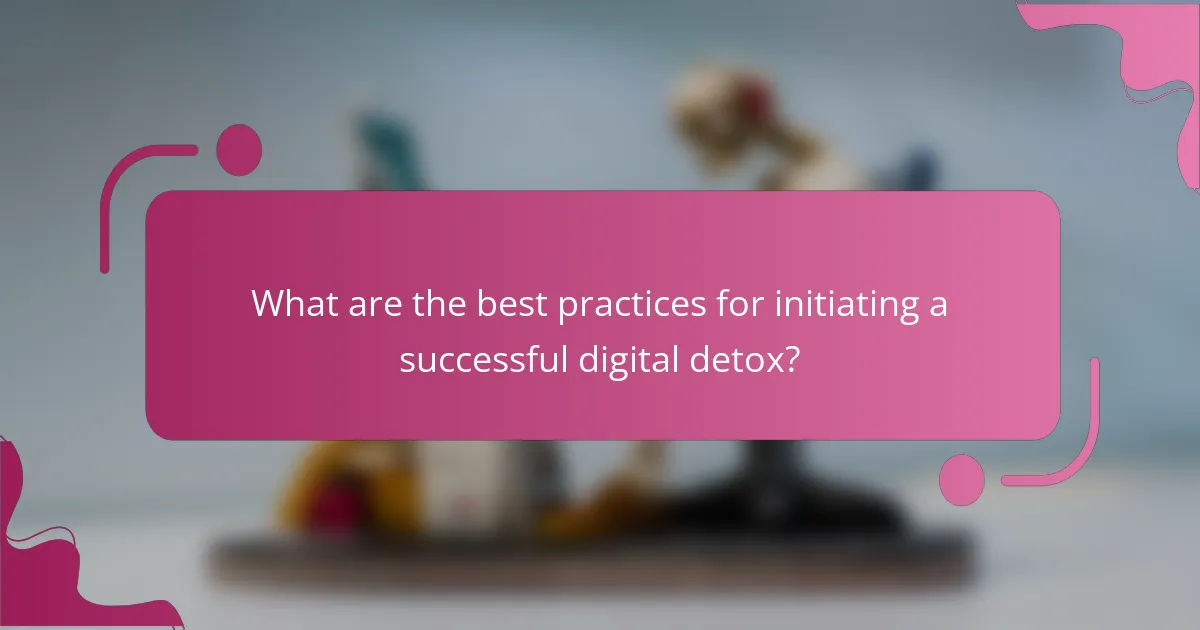
What are the best practices for initiating a successful digital detox?
To initiate a successful digital detox, set clear goals, establish boundaries, and choose a suitable duration. Focus on replacing screen time with activities that promote mental clarity, emotional well-being, and self-discovery.
1. Define your objectives: Identify specific reasons for the detox, such as reducing anxiety or improving focus.
2. Create a schedule: Decide on the length of the detox and plan activities to fill the time, like reading or exercising.
3. Limit digital access: Set specific times for device usage or designate tech-free zones in your home.
4. Engage in self-reflection: Use journaling or meditation to explore thoughts and feelings during the detox.
These practices enhance mental clarity and emotional well-being, fostering a deeper understanding of oneself.
Which techniques can help set realistic goals for a digital detox?
To set realistic goals for a digital detox, start by defining clear, achievable objectives. Break down your detox into manageable timeframes, such as one day or one week. Identify specific triggers that lead to excessive digital use and create strategies to address them. Track your progress regularly to maintain motivation and adjust your goals as needed. Engage in alternative activities that promote mental clarity and emotional well-being, such as reading, exercising, or spending time outdoors.
How can individuals measure their progress during a detox?
Individuals can measure their progress during a digital detox by tracking emotional shifts, mental clarity, and self-reflection. Regular journaling can reveal insights into emotional well-being. Setting specific goals, such as reducing screen time, provides measurable outcomes. Monitoring sleep quality and mood changes also indicates improvements. Engaging in mindfulness practices enhances self-discovery and helps gauge progress.
What common mistakes should be avoided when planning a digital detox?
Avoiding common mistakes in digital detox planning enhances mental clarity and emotional well-being. Key mistakes include setting unrealistic expectations, neglecting support systems, failing to define clear goals, and not allowing for gradual adjustments.
1. Setting unrealistic expectations: Expecting immediate results can lead to disappointment.
2. Neglecting support systems: Engaging friends or family can provide motivation and accountability.
3. Failing to define clear goals: Without specific objectives, the detox may lack direction.
4. Not allowing for gradual adjustments: Sudden withdrawal can cause anxiety; gradual changes promote better adaptation.
Addressing these mistakes fosters a more effective and fulfilling digital detox experience.
How can one create a supportive environment for a digital detox?
Creating a supportive environment for a digital detox involves establishing boundaries and fostering positive habits. Start by designating specific times for device use, ensuring ample offline activities are available. Encourage open communication about the detox experience, which can enhance emotional well-being. Incorporate nature and mindfulness practices to promote mental clarity. Lastly, create a physical space that minimizes digital distractions, enhancing the self-discovery process.
